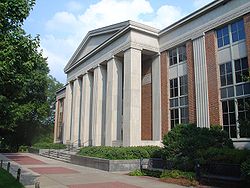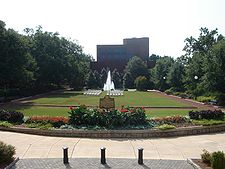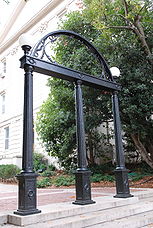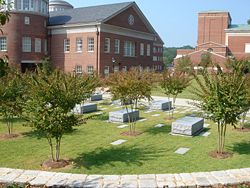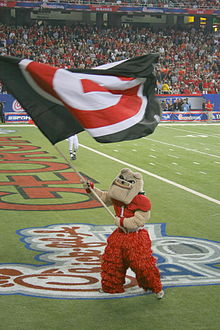- University of Georgia
-
University of Georgia 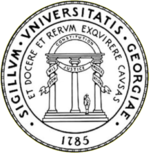
Seal of the University of GeorgiaMotto Et docere et rerum exquirere causas (l) Motto in English "Both to teach and to inquire into the nature of things." 'To serve' has been anachronistically added so the English motto now reads "To teach, to serve and to inquire into the nature of things" Established January 27, 1785 Type Public Land Grant and Sea Grant[1] President Michael F. Adams Students 34,885[2] Location Athens, Georgia, United States
33°57′21″N 83°22′28″W / 33.9558°N 83.3745°WCoordinates: 33°57′21″N 83°22′28″W / 33.9558°N 83.3745°WCampus "College town"; 615 acres (2.489 km2) Endowment US $572.5 million (UGA + The UGA Foundation + The Arch Foundation)[3] Colors Red and Black Nickname Bulldogs Mascot Uga (live), Hairy Dawg (costumed) Website http://www.uga.edu 
The University of Georgia (UGA) is a public research university located in Athens, Georgia, United States. Founded in 1785, it is the oldest and largest of the state's institutions of higher learning and is one of multiple schools to "claim" the title of the oldest public university in the United States. UGA offers seventy-nine degree programs in a wide range of disciplines and enrolls about 26,000 undergraduate and about 9,000 graduate students from the United States and around the world every year.
The university is organized into sixteen schools and colleges. In its 2011 edition, U.S. News & World Report ranked the university's undergraduate program 56th among national universities, while ranking the business, education, journalism, law, and public affairs graduate programs as high as 4th and all in the top 50. The same publication also cited the university as the #11 ranked "Up-and-Coming School" in the National University category tied with the University of Southern California and ahead of Emory University. It has also been recognized as one of the Public Ivies.[4] The university also made the list of "Top 10 Public Ivy League Schools" [5]The School of Environment and Design was named the #1 Landscape Architecture program for undergraduates in the nation, as well as #3 for post-graduate studies in the list of top 15 Landscape Architecture Schools for 2006.[6][7] Internationally, Georgia was ranked 84th in the 2011 QS World University Rankings[8].
UGA student athletes compete intercollegiately as the Bulldogs. As a member of the Southeastern Conference, the Bulldogs have won thirty-seven national championships and 130 conference championships.
Besides academics, research, and athletics, UGA is also well known for its campus in the acclaimed college town of Athens,[9] with dominant architectural themes of Federal—the older buildings—and Classical and Antebellum style. Situated on a 615-acre (2.49 km2) main campus, UGA has a workforce of more than 9,800, an annual budget of about $1 billion, and a physical plant valued at some $500 million, making it one of the largest employers in Georgia and a major contributor to the state's economic and cultural vitality.[10]
Contents
Organization
The President of the University of Georgia (currently Michael F. Adams) is the head administrator and is appointed and overseen by the Georgia Board of Regents.
The University comprises sixteen schools and colleges:
Colleges
- College of Agricultural and Environmental Sciences
- Franklin College of Arts & Sciences
- Terry College of Business
- College of Education
- College of Environment & Design
- College of Family and Consumer Sciences
- Henry W. Grady College of Journalism and Mass Communication
- College of Pharmacy
- College of Public Health
- College of Veterinary Medicine
Schools
- Daniel B. Warnell School of Forestry and Natural Resources
- Graduate School
- School of Law
- School of Public and International Affairs
- School of Social Work
- Eugene P. Odum School of Ecology
History
Antebellum history
The University of Georgia was incorporated on January 27, 1785, by the Georgia General Assembly, which had given its trustees, the Senatus Academicus of the University of Georgia, 40,000 acres (160 km²) for the purposes of founding a “college or seminary of learning.”[11] The Senatus Academicus was composed of the Board of Visitors and the Board of Trustees with the Georgia Senate presiding over those two boards. The first meeting of the university's board of trustees was held in Augusta, Georgia on February 13, 1786.[12] The meeting installed its first president, Abraham Baldwin, a native of Connecticut and graduate of Yale University. The college was not immediately established and portions of the original land tracts were used for other purposes or sold to raise $7,463.75 by 1798.[citation needed]
On July 2, 1799, the Senatus Academicus met again in Louisville, Georgia and decided that the time was right to officially begin the University. During this meeting 633 acres (2.6 km²) on the banks of the Oconee River were chosen on which the university was to be built. This tract of land, now a part of the consolidated city–county of Clarke County, Georgia and Athens, Georgia was then part of Jackson County. The meeting also established a new president of the university naming Josiah Meigs, another Yale graduate, to the post. The first classes were held in 1801, in what was called the Franklin College, named in honor of Benjamin Franklin. The first graduating class graduated on May 31, 1804.[citation needed]
The Senatus Academicus convened for the last time in Dothan, Georgia, from November 3, 1859, through November 5, 1859, after which it was replaced with a Board of Trustees which reported to the Georgia General Assembly which is composed of the Georgia House of Representatives and the Georgia Senate.
Civil War era
During the American Civil War, the University closed in October 1863 and reopened in January 1866 with an enrollment of seventy-eight students including veterans utilizing an award of $300 granted by the General Assembly to injured soldiers younger than thirty.[11] In that same year, the legislature appropriated $2,000 for the creation of a College of Agriculture and Mechanic Arts. This was the result of the Morrill Act which was used to create land grant colleges across the nation. The agricultural department within the University opened on May 1, 1872. A portion of the funds were used to establish a branch of the agricultural department in Dahlonega, Georgia which developed into North Georgia College.[13]
20th century
With students limited to white males for the first century of its history, UGA began educating female students during the summer of 1903. Women were not admitted as full-time undergraduates until 1918.[citation needed] Before official admission of women to the University, several women were able to complete graduate degrees through credit earned during the summer sessions. The first woman to earn such a degree was Mary Lyndon. She received a Master of Arts degree in 1914. Mary Creswell earned the first undergraduate degree in June 1919, a B.S. in Home Economics. Two UGA dormitories are named after these graduates: Creswell Hall and Mary Lyndon Hall.
Racial integration was achieved in 1961[citation needed], with the admission of Hamilton E. Holmes and Charlayne Hunter after notable tension with the Southern Association of Colleges and Schools. In 2001, on the fortieth anniversary of their having first registered for classes, the University renamed a prominent campus building in their honor: Holmes-Hunter Academic Building.[14] Although Hunter and Holmes were the first African-American students to matriculate at UGA, Mary Frances Early became the first African-American graduate by earning her master’s (MMEd) in music education in 1962. In 1963, Chester Davenport became the first African-American admitted to the UGA School of Law and its first African-American graduate (LL.B. 1966). A decade later, Sharon Tucker was the first female African-American law graduate, earning her J.D. in 1974.[15]
Recent years
The University has seen its academic reputation rise markedly since Georgia's HOPE Scholarship program was started in 1993. The school has grown both in size and reputation. The merit-based scholarship allows any resident of the state of Georgia to attend any public college in the state without paying tuition, provided they maintain a 3.0 GPA. The average SAT for students entering UGA in 2010 was 1263,[16] and national rankings place UGA among the top 20 public universities in America and a top 10 best value.[17] UGA is designated as both a land-grant and sea-grant university.[1] UGA's Henry W. Grady College of Journalism and Mass Communication awards the prestigious George Foster Peabody Awards, which are presented annually for excellence in television and radio news, entertainment and children’s programming. The University also presents the annual Delta Prize for Global Understanding, which recognizes individuals or groups whose initiatives promote peace and cooperation among cultures and nations. UGA has an extensive network of student activities that center around academic, religious, social and fraternal organizations. It maintains one of the South's oldest and most active Greek systems, and the fraternity and sororities maintain homes both on and off campus. Organizations include both Democratic and Republican student clubs, Order of Omega, Arch Society, student philanthropies such as UGA Heros,[18] UGA Habitat, UGA Miracle and UGA Relay for Life,[19] and secret societies such as Palladia and Gridiron. The university's National Alumni Association has over 50,000 members and operates a center in both Athens and Atlanta, Georgia which can be found in the Atlanta Financial Center.
Campus
Though there have been many additions, changes, and augmentations, UGA’s campus maintains its historic character. The historical practice has been to divide the 614-acre (2.5 km2) main campus into two sections, North Campus and South Campus. Since 1995, new facilities serving the arts, academics, fitness and student housing have been built on what has come to be known as "East Campus."[20] This area includes new apartment-like dorms called East Campus Village. Adjacent is the newest and fourth dining hall on campus called The Village Summit at Joe Frank Harris Commons. Also on East campus is the Performing and Visual Arts Complex, the Ramsey Center for Physical Activity and the relocated Lamar Dodd School of Art. "West Campus" refers to the area adjacent to the main campus where many of UGA's largest residence halls are located; most UGA freshmen live in one of the high-rise dorms on West Campus.
Tradition maintains that UGA's oldest permanent building, Old College, is modeled on Yale University’s Connecticut Hall.[21] UGA’s North Campus contains the picturesque historic buildings—such as the Chapel,[22] New College, Demosthenian[23] and the Phi Kappa[24] Halls, Park Hall,[25] Meigs Hall, and the President’s office[26]—as well as modern additions such as the Law School[27] and the Main Library.[28] The dominant architectural themes are Federal—the older buildings—and Greco-Roman Classical/Antebellum style. UGA’s North Campus has also been designated an arboretum by the State of Georgia.
A notable North Campus fixture is the cast-iron gateway that stands at its main entrance. Known as "The Arch" (but often erroneously pluralized to "The Arches"), the structure was patterned after the Seal of the State of Georgia, and has faced historic downtown Athens ever since it was erected in the 1850s.[29] Although the Seal's three pillars represent the state's three branches of government,[30] the pillars of The Arch are usually taken to represent the Georgia Constitution's three principles of wisdom, justice, and moderation, which are engraved over the pillars of the Seal. There is a superstition about walking through The Arch. It is said that if you walk under the Arch before receiving your diploma, you will not graduate from UGA on time.[31] Another legend claims that should you walk through The Arch as a freshman, you will become sterile. [32]
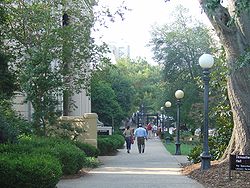 Path on North Campus leading to the Arch and downtown Athens
Path on North Campus leading to the Arch and downtown Athens
Dividing North and South Campus is the "central campus" area, home of the University Bookstore, Tate Student Center, and Miller Learning Center, as well as Sanford Stadium, home of the football team. Adjacent to the stadium is a bridge that crosses Tanyard Creek and is the traditional crossover into South Campus, home of most of the science and agricultural classroom buildings. Further south and east, across East Campus Road, is East Campus, home of the Ramsey Center, the East Campus Village (apartment-style dormitories), and several fine arts facilities, including the Georgia Museum of Art and the Hugh Hodgson School of Music. A new facility for the art school opened its doors in the Fall of 2008.[citation needed] This new state-of-the-art facility replaced the elder that was placed on North Campus.
Adjacent to the campus is the "west campus" area. This extends from the corner of Britain Avenue and Lumpkin Street in the south to Waddell and Wray streets in the north. It is bordered along the east by Lumpkin Street and on the west by Church Street south of Baxter Street and Florida Avenue to the north. Located on the south end are several dormitories including the Hill Community, Oglethorpe House, Creswell Hall, Brumby Hall and Russell Hall. Also located here are Legion Field and Pool, which are recreational facilities.
Academic and research facilities
The university is notably not a member of the prestigious Association of American Universities (AAU), a nonprofit 501(c)(3) organization of 61 leading public and private research universities in the United States and Canada. A recent article in The Chronicle of Higher Education notes that "[w]hile AAU membership conveys a certain cachet, several well-known research heavyweights, such as Boston University, Dartmouth College, North Carolina State University, and the University of Georgia, are not members."[33] However, the university is regarded as a research heavyweight that can make good arguments for joining. [34] The AAU's membership criteria focus primarily on the amount of competitive research funds, and the share of faculty members who belong to the National Academies. Despite the stated importance of research as a criterion, some universities left out of the AAU outpace member institutions. [35] According to The Chronicle of Higher Education's analysis, at least 11 institutions received more federal money in 2008 than did 13 members, and six received more than 19. [36] Some critics of the association's influence say the reason universities pay it so much attention is because of the stingy and slow admissions process. [37]
Miller Learning Center
The $43.6 million dollar Zell B. Miller Learning Center (MLC) has been the largest academic building on the University of Georgia campus since its opening in the autumn of 2003 when it was originally called the Student Learning Center (which explains why some students still refer to it as the SLC).[38] Located at the heart of the UGA campus, it houses both classroom space and library space in close proximity.
On the inside is a technological space that includes two dozen classrooms capable of seating 2,400 students and equipped with the latest technology. The building serves as an expansion of UGA library services, with a completely electronic library, 276,000 sq ft (25,600 m2). of actual floor space.
Paul D. Coverdell Center for Biomedical and Health Sciences
Named after U.S. Senator Paul D. Coverdell, this $40 million dollar facility totals 140,000 square feet (13,000 m2), giving enough room for 25 research teams or roughly 275 scientists, staff and graduate students. The Center was designed mainly to maximize energy efficiency.[39] Laboratory intensive groups at the Coverdell Center include the Center for Tropical and Emerging Global Diseases (CTEGD), the Developmental Biology Group (DBG), and the Bio-Imaging Research Center (BIRC),the Health and Risk Communications Group (HRCG), the administrative homes of the College of Public Health (CPH) and the Biomedical Health Sciences Institute (BHSI), and the CPH’s Department of Health Administration, Biostatistics and Epidemiology.[40] Former President George H.W. Bush spoke at the Center's grand opening in 2006.[citation needed]
Artificial Intelligence Center
The Artificial Intelligence Center is an interdepartmental research and instructional center within the Franklin College of Arts and Sciences of the University of Georgia.
The Artificial Intelligence (AI) Center houses two degree programs, the Master of Science program in Artificial Intelligence and the bachelor's degree program in Cognitive Science. Over the years the AI Center has received funding for research from the National Science Foundation, the Environmental Protection Agency, the Department of Energy, the Department of Agriculture, GlaxoSmithKline Research & Development Ltd., the Georgia Research Alliance, Centro Internacional por Agricultura Tropical, Clemson University, Medical College of Georgia, and the American Association for Artificial Intelligence.
University of Georgia Marine Institute
The university's campus also spreads to Sapelo Island, off the Georgia coast, which is home to the University of Georgia Marine Institute, a nearshore ecological and geological research institute.
The Georgia Center, the University of Georgia's Conference Center and Hotel is located on South Campus. The Georgia Center includes 200 hotel rooms including suites, four onsite dining options, banquet areas, conference rooms, auditoriums, a fitness center, and a computer lab. The Georgia Center is open to all visitors to Athens and UGA.
Coastal Plain Research Arboretum
The Coastal Plain Research Arboretum (38 acres (150,000 m2)) is an arboretum in Tifton, Georgia, located on the grounds of the Tifton Campus of the University of Georgia.[41]
The arboretum was established in 1987, with plant development and selection starting in 1991.[42] It consists of stream-side forest and wetland, and is dedicated to native plant species of the Georgia coastal plain.[41]
The arboretum contains pine woods, a native azalea collection, and approximately 280 taxa of native trees, shrubs, and herbaceous plants.[41] It is one of several institutions active in efforts to conserve the endangered Torreya taxifolia.[43] The arboretum director is John M. Ruter, professor of horticulture at the university's Tifton campus.[44]
Student facilities
Ramsey Center
The Ramsey Center is the student recreational and athletic facility located on East Campus at the University of Georgia. The Ramsey Center is one of the largest student athletic/recreation facilities in the United States built and was named in honor of Bernard and Eugenia Ramsey. The campus's eight-acre Ramsey Student Center for Physical Activities has 2 gyms, 3 pools (one Olympic-sized, a 17-foot (5.2 m) diving well, and a lap pool), a 1/8 mile indoor suspended rubberized track, a 44 feet (13 m)-high climbing wall, 14-foot (4.3 m) outdoor bouldering wall, 10 racquetball courts, 2 squash courts, 8 full-length basketball courts, and 19,000 square feet (1,770 m2) of weight-training space.[45] This $40 million structure was named by Sports Illustrated as the best recreational sports facility in the country.[46]
Franklin Residential College
Franklin Residential College[47] is a residential college, based on the Oxford and Cambridge model. It is a collaboration of the Franklin College of Arts and Sciences, the University Housing office, and the Vice President of Instruction. It was founded in 2000.[48] The home of the college is Rutherford Hall, which was built in the late 1930s as a women's dormitory.
Tate II Expansion
On Thursday, April 19, 2007, ground was officially broken for the $52 million Tate Student Center Expansion and Renovation project.[49] A multi-level parking deck began the first phase of the construction on which the new Student Center was built. Tate II officially opened its doors on June 1, 2009.
Included in the new student center is: an 11,000-square-foot (1,000 m2) multi-purpose space on the fifth floor, a dining room, meeting rooms, and lounge seating on the fourth floor, a food court, retail space, Print & Copy Services, a large lounge area, gaming area, and open performance space on the third floor. The new food court is operated by UGA Food Services. It includes Hotei's, a hibachi style grill, Larry's Giant Subs, and Barberitos. Some of the amenities, such as the Bulldog Cafe and the Tate Theatre, will remain in the old Tate Center. The total cost of the new expansion is approximately $58.2 million.[citation needed]
Construction on the $13.5 million, 500-space Tate Student Center parking deck was underway through May 2009.[citation needed]
Other facilities
Construction on the $39.2 million, 171,000 sq ft (15,900 m2). Lamar Dodd School of Art is underway through spring 2008. The site is just south of the existing Performing and Visual Arts Complex on East Campus.
The Georgia Museum of Natural History has one of the most extensive natural history collections in Georgia.
The Georgia Center, the University of Georgia's Conference Center and Hotel is located on South Campus. The Georgia Center includes 200 hotel rooms including suites, four onsite dining options, banquet areas, conference rooms, auditoriums, a fitness center, and a computer lab. The Georgia Center is open to all visitors to Athens and UGA.
Academics
University rankings (overall) National Forbes[50] 64 U.S. News & World Report[51] 62 Washington Monthly[52] 89 Rhodes Scholars
As of 2008, twenty-one UGA students have been named Rhodes Scholars including Eugene T. Booth and Hervey M. Cleckley. UGA student Deep Shah and alumna Kate Vyborny were elected in 2008, making the University the only public institution with two scholars in one year and one of only six universities with multiple scholars in a year.[53] In 2010, Tracy Yang was named a Rhodes Scholar.
Study Abroad Program
The University of Georgia began its first year-round residential study-abroad program at Oxford University in England, where students and faculty live in a three-story Victorian house located in the heart of the city of Oxford and owned by UGA. Founded in 1987 the Oxford study abroad program began as a summer option and expanded to include spring in 1994. With the purchase of the house in 1999 – evidence of UGA's strong commitment to study abroad – the program became available throughout the academic year.
The University of Georgia owns two other international residential centers as well: one in Cortona, Italy; the other, and UGA's largest, in San Luis de Monteverde, Costa Rica. The UGA Costa Rica campus currently comprises 155 acres (0.63 km2) and over 36,000 square feet (3,300 m2) of built space nestled in the country's mountainous Monteverde Cloud Forest, a region that has been celebrated in publications such as Forbes Traveler, Newsweek, and National Geographic. Ever expanding its programmatic offerings, UGA Costa Rica annually offers 23 study abroad programs in 28 disciplines across the fall, spring, Maymester, and summer terms.
UGA now ranks among the top five American universities for the number of students studying abroad, with more than 100 programs in over 50 countries. UGA has faculty study abroad programs on every continent, including Antarctica. Additionally, UGA has signed agreements with several outside study abroad organizations: the American Institute For Foreign Study; Australearn; the Institute for Study Abroad (IFSA), Butler University; International Studies Abroad (ISA); the The School for Field Studies; the University of New Orleans, Innsbruck International Summer School.[54] Currently, just over 2,000 students, or 6% of the entire campus enrollment (graduate and undergraduate) study abroad in a given year. During the past five years, the number of students participating in study abroad programs has nearly doubled. Approximately 30 percent of the members of recent graduating classes had a study abroad experience.[55]
Athletics
Main article: Georgia BulldogsSee also: Clean, Old-Fashioned Hate, Deep South's Oldest Rivalry, and Florida vs. Georgia Football ClassicThe University of Georgia varsity athletic teams participate in the NCAA's Division I-A as a member of the Southeastern Conference. Since the 1997-1998 season, UGA has seven top ten rankings in the National Association of Collegiate Directors of Athletics (NACDA) Directors' Cup, a numerical ranking based on the success of universities in all varsity sports.[56] The University has won national championships in football, women's gymnastics, women's equestrian (2003, 2004, 2008, 2009, 2010), baseball, tennis (men's and women's), golf (men's and women's), and women's swimming and diving. The Gym Dogs, the University's women's gymnastics team, have a NCAA-leading 10 national championships in gymnastics, including five consecutive championships from 2005 to 2009.
The Bulldogs' most historic rivalry is with Auburn, referred to as the "Deep South's Oldest Rivalry" in reference to the first football game played between the two teams in 1892 and the more than one hundred meetings since. However, major rivalries have grown since, including the rivalry with the Florida Gators, the nearby Georgia Tech Yellow Jackets, and the Tennessee Volunteers.
The University also boasts several non-varsity sports, including wrestling,[57] men's and women's soccer, crew,[58] ultimate frisbee,[59][60] rugby, lacrosse, and ice hockey. Georgia's men's soccer team received a bid to play in the NIRSA Club National Championship for the first time in 2007. Several Varsity sports are duplicated with non-varsity teams, such as women's tennis. Georgia's men's lacrosse team has won the South Eastern Lacrosse Conference three times, in 1998, 2007, and 2008, and received an automatic bid to the MCLA national tournament; while the women's team earned an at-large bid to the WDIA National Tournament in 2007.
Most recently, many have acclaimed UGA's athletic program for implementing a program that fines student-athletes for unexcused absences in class. And, for the first time in school history, more than 50% of student-athlete GPAs were over 3.0. In addition, many other universities are looking to UGA's plan as a model.[citation needed]
Although they are not an athletic team, UGA's majorette line and feature twirlers has won numerous national titles making them the most award collegiate majorette line in America.[citation needed] As for the feature twirler, currently Karrissa Wimberley (a 15-time world champion baton twirler) has the position.[citation needed]
Student life
Student housing
Main article: Housing at the University of GeorgiaGreek life
Main article: Greek life at the University of GeorgiaThe first Greek letter fraternity to charter at the university was Sigma Alpha Epsilon in 1865, and the first sorority was Phi Mu in 1921. There are 17 sororities from the Panhellenic Council and 26 IFC fraternities. Students with Greek affiliation made up 23 percent of the undergraduate student body as of 2007, including 21% of the males and 24% of the females.[61] Perhaps the most prominent features of Greek Life at the University are the large, mostly Greek Revival, mansions maintained by the national fraternities and sororities as chapter houses lining South Milledge Avenue and South Lumpkin Street and the ubiquitous t-shirts worn by students on campus commemorating Greek social events.
In 2005 the University announced that five of the fraternities on Lumpkin Street would need to be relocated by June 2008. The school plans to build academic buildings on the house sites, which the University owns and the fraternities lease. UGA offered to relocate the Lumpkin fraternities and two others to River Road (a former site of several fraternities who were moved out in the 90's), located on East Campus. Kappa Alpha Order and Chi Phi did not take up the offer and have decided to move off campus. Sigma Chi, having signed a renewable 40-year land lease with the University in 1996[62], continues to maintain their house next to the Student Learning Center (now the Zell B. Miller Learning Center). In October 2008, Pi Kappa Alpha, Phi Delta Theta, Tau Epsilon Phi and Sigma Nu broke ground for the new Greek Park located on River Road. The four new houses will be complete August 2009 for fall rush. All groups have signed 30 year leases with an option to renew for an additional 30 years.
Noted people
Main article: List of University of Georgia peopleSee also
- List of forestry universities and colleges
- The Green Hand
- University of Georgia Press
- WUGA-TV
Notes
- ^ a b "University of Georgia: Role/Mission". http://www.uga.edu/profile/mission.html.
- ^ "UGA once again breaks record with enrollment of 34,885". UGA Office of Public Affairs. 2009-10-15. http://www.uga.edu/news/artman/publish/091015enrollment_record.shtml. Retrieved 2009-11-25.
- ^ "U.S. and Canadian Institutions Listed by Fiscal Year 2009 Endowment Market Value and Percentage Change in Endowment Market Value from FY 2008 to FY 2009". nacubo.org. http://www.nacubo.org/Documents/research/2009_NCSE_Public_Tables_Endowment_Market_Values.pdf. Retrieved 3 December 2010.
- ^ "Greenes' Guides: The Public Ivies". http://www.amazon.com/gp/reader/006093459X/. Retrieved May 16, 2007. "Comparing Black Enrollments at the Public Ivies". jbhe.com. http://www.jbhe.com/news_views/49_blackenrollment_publicivies.html. Retrieved 3 December 2010.
- ^ "Top 10 Public Ivy League Schools". coedmagazine.com. http://coedmagazine.com/2010/10/20/the-top-ten-public-ivies/. Retrieved 20 July 2011.
- ^ "DesignIntelligence Releases List of Top Landscape Architecture Schools". LAND online: landscape architecture news digest (American Society of Landscape Architects). December 19, 2005. Archived from the original on 2007-12-14. http://web.archive.org/web/20071214220858/http://www.asla.org/land/121905/designintelligence.html. Retrieved 2008-02-07.
- ^ "Landscape Architecture Schools: The Top 15". LandscapeOnline (Landscape Communications). February 10, 2006. http://www.landscapeonline.com/research/article/6408. Retrieved 2008-02-07.
- ^ http://www.topuniversities.com/university-rankings/world-university-rankings/2011?page=1
- ^ "Best College Town Rankings". http://www.msnbc.msn.com/id/9593731/.
- ^ "University of Georgia article at The New Georgia Encyclopedia". georgiaencyclopedia.org. http://www.georgiaencyclopedia.org/nge/Article.jsp?path=/Education/HigherandPostsecondaryEducation/PublicHigherEducation/ResearchInstitutions&id=h-1059. Retrieved 29 December 2010.
- ^ a b Dendy, Larry B. (2009-01-23). "University of Georgia". http://www.georgiaencyclopedia.org/nge/Article.jsp?id=h-1059&sug=y. Retrieved 2010-01-07.
- ^ Lucian Lamar, Knight (1913). Volume 1 of Georgia's Landmarks, Memorials, and Legends. Byrd Printing Company. pp. 139. http://books.google.com/?id=lEkUAAAAYAAJ&printsec=frontcover&q=university.
- ^ Roberts, William Pittman (1998). Georgia’s Best Kept Secret: A History of North Georgia College. Dahlonega, Ga: Alumni Association of North Georgia College. http://www.northgeorgiaalumni.org/Page.aspx?pid=297.
- ^ Dendy, Larry B. (November 27, 2000). "Registering historic steps: Academic Building to be named for Holmes and Hunter". Columns Faculty/Staff News (University of Georgia). http://www.uga.edu/columns/001127/front2.html. Retrieved 2008-01-31.
- ^ "Campus News:Sibley lecturer Chester Davenport says Horace Ward was his inspiration". Georgia Magazine (University of Georgia) 83 (3). June 2004. http://www.uga.edu/gm/604/FrontNews.html. Retrieved 2008-05-25.
- ^ Admissions.uga.edu
- ^ UGA.edu
- ^ UGAheros.org
- ^ UGArelay.org
- ^ UGA.edu
- ^ "Campus map - Yale University". http://www.yale.edu/campusmap/central_old.html.
- ^ "The University of Georgia Chapel". http://chapel.myweb.uga.edu/. Retrieved 3 December 2010.
- ^ "Demosthenian Literary Society: About Demosthenian Hall". http://www.uga.edu/~demsoc/thehall.htm.
- ^ "Phi Kappa Hall". http://iep.cviog.uga.edu/Athens/historicimg/PHIKAPPA.htm.
- ^ UGAdog.com
- ^ "UGA President's Office". http://www.uga.edu/presofc/.
- ^ "University of Georgia School of Law". http://www.lawsch.uga.edu/.
- ^ "University of Georgia Libraries". http://www.libs.uga.edu/.
- ^ "UGA Arch". http://www.cviog.uga.edu/Projects/gainfo/UGA/UGAarch.htm.
- ^ "State Seal". http://sos.georgia.gov/state_symbols/state_seal.html. Retrieved 2008-01-25.
- ^ "University of Georgia: History". http://www.uga.edu/profile/arch.html.
- ^ Gibbs, C. (2010). God and Football: Faith and Fanaticism in the SEC. Grand Rapids, MI: Zondervan.
- ^ "Nebraska's Ouster Opens a Painful Debate Within the AAU". chronicle.com. http://chronicle.com/article/Ouster-Opens-a-Painful-Debate/127364/. Retrieved 20 July 2011.
- ^ "As AAU Admits Georgia Tech to Its Exclusive Club, Other Universities Await the Call". chronicle.com. http://chronicle.com/article/As-AAU-Admits-Georgia-Tech-to/65200/. Retrieved 20 July 2011.
- ^ "Nebraska's Ouster Opens a Painful Debate Within the AAU". chronicle.com. http://chronicle.com/article/Ouster-Opens-a-Painful-Debate/127364/. Retrieved 20 July 2011.
- ^ "As AAU Admits Georgia Tech to Its Exclusive Club, Other Universities Await the Call". chronicle.com. http://chronicle.com/article/As-AAU-Admits-Georgia-Tech-to/65200/. Retrieved 20 July 2011.
- ^ "As AAU Admits Georgia Tech to Its Exclusive Club, Other Universities Await the Call". chronicle.com. http://chronicle.com/article/As-AAU-Admits-Georgia-Tech-to/65200/. Retrieved 20 July 2011.
- ^ "Georgia Magazine". http://www.uga.edu/gm/1203/Feat2.html.
- ^ "University of Georgia: News & Information". http://www.uga.edu/news/artman/publish/060407-Coverdell.shtml.
- ^ "Three University of Georgia researchers elected Fellows of American Academy of Microbiology". ovpr.uga.edu. http://www.ovpr.uga.edu/coverdell/index.html. Retrieved 3 December 2010.
- ^ a b c Coastal Plain Research Arboretum, ExploreGeorgia.org (Georgia's official tourism website), accessed June 22, 2011.
- ^ John M. Ruter, Development of New Ornamental Plants at the University of Georgia Tifton Campus, METRIA 2002: Landscape Plant Symposium: Plant Development and Utilization, Program and Selected Papers. Asheville, North Carolina. May 23-25, 2002.
- ^ Hank Bruno, Research Project: Safeguarding Torreya taxifolia, Georgian Plant Conservation Alliance website, accessed June 22, 2011
- ^ John M. Ruter, Faculty Biography, University of Georgia College of Agricultural and Environmental Sciences, accessed June 22, 2011
- ^ Recsports.uga.edu
- ^ Georgiadogs.com
- ^ "Franklin Residential College :: Welcome". http://www.uga.edu/frc/index.html.
- ^ The University of Georgia. "Franklin Residential College". University of Georgia website. http://www.uga.edu/frc/index.html. Retrieved 2007-02-11.
- ^ "Tate Student Center". http://www.uga.edu/campuslife/facilities/tate2/index.html. Retrieved 3 December 2010.
- ^ "America's Best Colleges". Forbes. 2011. http://www.forbes.com/top-colleges/list/. Retrieved October 6, 2011.
- ^ "National Universities Rankings". America's Best Colleges 2012. U.S. News & World Report. September 13, 2011. http://colleges.usnews.rankingsandreviews.com/best-colleges. Retrieved September 25, 2011.
- ^ "The Washington Monthly National University Rankings". The Washington Monthly. 2011. http://www.washingtonmonthly.com/college_guide/rankings_2011/national_university_rank.php. Retrieved August 30, 2011.
- ^ Shearer, Lee (December 16, 2007). "UGA pair headed to Oxford in coup for public university". Athens Banner-Herald. Morris Communications. http://www.onlineathens.com/stories/121607/uganews_20071216079.shtml. Retrieved 2008-03-28.
- ^ "Study Abroad". uga.edu. http://www.uga.edu/oie/sa_prog_affiliates.htm. Retrieved 3 December 2010.
- ^ "Study Abroad Risk Management Training". uga.edu. http://www.uga.edu/oie/studyabroad.htm. Retrieved 3 December 2010.
- ^ "National Association of Collegiate Directors of Athletics - Directors Cup". http://nacda.cstv.com/directorscup/nacda-directorscup-previous-scoring.html.
- ^ "UGA Wrestling". http://www.uga.edu/wrestling/.
- ^ "The University of Georgia Rowing Club". http://www.ugacrew.org/.
- ^ "UGA Hodawgs". http://www.uga.edu/womensultimate/.
- ^ "Jojah Intro". uga.edu. http://www.uga.edu/ultimate/. Retrieved 3 December 2010.
- ^ "Panhellenic Council". http://www.uga.edu/panhellenic/.
- ^ http://redandblack.com/2006/11/01/frats-question-building-costs/
Further reading
- Boney, F.N. A Pictorial History of the University of Georgia. Athens, GA: U of Georgia P, 2000
- Johnson, Amanda Georgia as Colony and State. Atlanta, Georgia: Walter W. Brown Publishing Co., 1938, pp. 187, 247, 376, 429-430, 569-570
External links
University System of Georgia Research Universities Georgia Institute of Technology (Georgia Tech) • Georgia Health Sciences University • Georgia State University • University of GeorgiaRegional Universities State Universities Albany State University • Armstrong Atlantic State University • Augusta State University • Clayton State University • Columbus State University • Fort Valley State University • Georgia College & State University • Georgia Southwestern State University • Kennesaw State University • North Georgia College & State University • Savannah State University • Southern Polytechnic State University (Southern Poly) • University of West GeorgiaState Colleges Abraham Baldwin Agricultural College • Atlanta Metropolitan College • College of Coastal Georgia • Dalton State College • Darton College • East Georgia College • Gainesville State College • Georgia Gwinnett College • Georgia Highlands College • Georgia Perimeter College • Gordon College • Macon State College • Middle Georgia College • South Georgia CollegeTwo-year Colleges Independent research unit Governing body Southeastern Conference Eastern Division Florida Gators • Georgia Bulldogs • Kentucky Wildcats • South Carolina Gamecocks • Tennessee Volunteers and Lady Vols • Vanderbilt Commodores

Western Division Future members Former members Sewanee Tigers (1932–1940) • Georgia Tech Yellow Jackets (1932–1964) • Tulane Green Wave (1932–1966)
Championships & awards National championships • Conference champions
Media SEC Network • SEC on CBS
Public Ivy universities Richard Moll's 1985 listOriginal Eight "Worthy Runners-Up" Binghamton University, State University of New York • University of Colorado at Boulder • Georgia Institute of Technology • University of Illinois at Urbana-Champaign • New College of Florida • Pennsylvania State University • University of Pittsburgh • University of Washington at Seattle • University of Wisconsin–MadisonGreenes' Guides 2001 listEastern Binghamton University, State University of New York • College of William & Mary • Pennsylvania State University • Rutgers, The State University of New Jersey • University of Connecticut • University of Delaware • University of Maryland • University of North Carolina at Chapel Hill • University of Virginia • University of VermontWestern Great Lakes & Midwest Indiana University • Miami University • Ohio State University • University of Illinois • University of Iowa • University of Michigan • Michigan State University • University of Minnesota • University of WisconsinSouthern University of Florida • University of Georgia • University of Texas at AustinCategories:- University System of Georgia
- University of Georgia
- 1801 establishments in the United States
- 1785 establishments in the United States
- Universities and colleges accredited by the Southern Association of Colleges and Schools
- Association of Public and Land-Grant Universities
- Land-grant universities and colleges
- Educational institutions established in the 1780s
- Universities and colleges in Georgia (U.S. state)
- Athens, Georgia
- Flagship universities in the United States
- Education in Clarke County, Georgia
- Buildings and structures in Athens, Georgia
- Visitor attractions in Athens, Georgia
- Education in Tift County, Georgia
Wikimedia Foundation. 2010.

